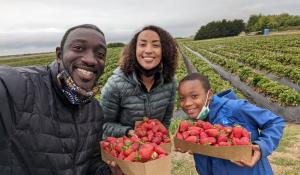
Our current agricultural system relies on toxic chemicals and practices that endanger the health of ecosystems, farmers, farmworkers, and our climate. No matter who you are or where you live in the US, this broken system impacts your life, but there’s a better way.
Regenerative agriculture is the answer to the dual crises of a global climate and a food system that are both becoming increasingly unstable. It’s all about rebuilding soil to capture carbon and, in return, grow healthier food and protect ecosystems.
Through Green America’s work with consumers and stakeholders from the entire food supply chain, huge amounts of land have been converted to regenerative acreage—and the work is just beginning. Regenerative agriculture points the way forward to a truly green food system that reduces pesticides, increases yields, and supports those working to feed us all.
Individual Actions
Meaningful action starts with you. These small changes combined have the potential for global impact.
1. Reduce food waste
Those moldy leftovers in the back of your fridge have major environmental impacts. Eight percent of global greenhouse gas emissions come from food waste, and in high-income countries like the US, consumers waste over one third of their food. That’s billions of pounds of food—not to mention the packaging, transportation, land, and other resources going to waste. Cutting global food waste in half by 2050 would reduce greenhouse gas emissions the same as running 17 million wind turbines for a year! Buying only what you need and eliminating food waste from your kitchen can save $1,500 for a family of four a year, according to the USDA.
How can I reduce my food waste?
- Plan your meals ahead of time to avoid overbuying and impulse purchases.
- Have go-to “clean out the fridge” recipes and make use of your freezer for items you may not be able to eat in time.
- Over 50 percent of what we throw away is compostable. Composting captures carbon, filters out stormwater pollutants, and gives scraps a second life feeding the soil rather than contributing to methane emissions in the landfill. Either start your own compost or use a composting service to support green jobs. You can find the how-to knowledge to make your own compost at greenamerica.org/green-living/how-and-what-compost.
2. Grow a Climate Victory Garden
It doesn’t matter if you’re a beginner or seasoned expert, whether you have a giant yard to grow in or just a few pots on a sunny windowsill—everyone can garden for the climate. During the WWII era, American gardens grew 40 percent of the country’s fresh fruits and vegetables. We can harness that power of collective action again, this time for the climate. Join over 4,000 gardens already at it, capturing 11,000 tons of carbon and offsetting emissions equivalent to driving 90 million miles. Register Your Climate Victory Garden on our website.
How can I garden in a way that’s good for the planet?
- Grow ultra-local food in your garden to offset the fossil fuels associated with food from grocery stores that travels an average of 1,500 miles. Growing your own food can save you money too, around $600 per year depending on what you plant.
- Cover and protect soils with mulch to decrease water use, curb erosion, and capture carbon.
- Create DIY solutions with household products instead of toxic pesticides.
- Instead of nitrogen-based fertilizers, opt for compost. These practices ensure your safety and could save you around $115/year (on average homeowners, spent on fertilizer, weed killer, and insecticides).
- Encourage biodiversity by choosing plants for pollinators. Giving bees and butterflies refuge in your garden will benefit your crops and support these important species.
3. Eliminate Your Lawn
Turf grass is our country’s largest irrigated crop—covering an area larger than the state of New York and demanding millions of tons of toxic fertilizers and pesticides each year. This manicured and over-managed land is devoid of diversity and a major source of water pollution and climate emissions. Just one hour of using a gasoline lawn mower is equal to greenhouse gas emissions of driving 300 miles.
How to Change Lawns Into Something Better
Plant a low-maintenance meadow instead, which provides pollinator habitat, encourages biodiversity, and captures carbon. Plus, you could save time—the average American spends 70 hours a year maintaining their lawn. Landscape with trees and perennial plants that don’t have to be replanted each year.
4. Buy organic, non-GMO, and regenerative
It matters how our food is grown. When you buy from producers that replenish and restore their lands and surrounding ecosystems, you’re sending a clear message in support of these practices. Organic, non-GMO, and regenerative products are better for the environment, but they’re also better for workers across the food system and the loved ones you’re cooking for. A 2019 study from University of California showed that eating organic food for just a week can reduce the levels of pesticides in the body by 60 percent on average.
How Purchases Can Create A Better Food System
- Buy less: Reduce your consumption of animal products from concentrated animal feed lots that wreak havoc on local to global ecosystems. Livestock-raising operations account for nearly 15 percent of total global greenhouse gas emissions each year, according to the UN Food and Agriculture Organization.
- Buy better: Use Regeneration International’s Regenerative Farm Map to help you find meats and dairy products (which have the greatest climate impact) from local regenerative sources.
- Buy local: Buy from local food co-ops, Community-Supported Agriculture (CSA), farmers markets, and local food hubs. Talk to your farmers about their practices and how they care for their soil, asking what actions they take to mitigate their climate impact. Buying local food isn’t just good for your carbon footprint, it significantly boosts the local economy, as $68 out of every $100 stays in the community when spent at a local business.
Actions to Take in Your Neighborhood and Community
Every community is unique. Use these suggestions as a springboard to inspire actions you can take beyond your immediate surroundings to grow climate solutions and a better food system.
Start a community, school, or other publicly-accessible garden to increase local food access and green space. Ask your local grocery stores to carry more organic, non-GMO, and regenerative options. Show your receipts to show that you’re a regular customer. Encourage friends to do the same.
Engage with local government and green groups that work on issues that could increase your community’s impact like starting a curbside compost program.
Actions to Reach Beyond Your Community
Grassroots action is critical for change, but a healthy climate and food system also depends upon high-level laws, regulations, and corporate compliance.
- Understand soil health legislation in your state: Around 20 states have existing or proposed soil health legislation that addresses soil’s role in the climate crisis. Look up your state’s status on NerdsForEarth.com and contact your representatives to let them know you support healthy soils legislation.
- Write a letter to a company: Love the regenerative practices behind Annie’s Organic Mac & Cheese or Patagonia’s cotton tees? Or, have a favorite brand that you think could do better? Let them know!
- Contact your representative about national-scale bills: There are numerous bills for national-level climate action that need support in all 435 Congressional Districts, and many of these focus on food issues, like the H.R.5861—Agriculture Resilience Act. Find this bill and more at ClimateCrisisPolicy.org.







